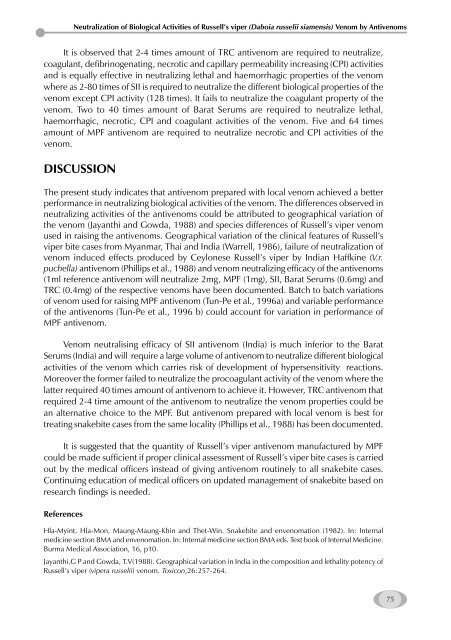Management of Snakebite and Research Management of Snakebite ...
Management of Snakebite and Research Management of Snakebite ...
Management of Snakebite and Research Management of Snakebite ...
Create successful ePaper yourself
Turn your PDF publications into a flip-book with our unique Google optimized e-Paper software.
It is observed that 2-4 times amount <strong>of</strong> TRC antivenom are required to neutralize,<br />
coagulant, defibrinogenating, necrotic <strong>and</strong> capillary permeability increasing (CPI) activities<br />
<strong>and</strong> is equally effective in neutralizing lethal <strong>and</strong> haemorrhagic properties <strong>of</strong> the venom<br />
where as 2-80 times <strong>of</strong> SII is required to neutralize the different biological properties <strong>of</strong> the<br />
venom except CPI activity (128 times). It fails to neutralize the coagulant property <strong>of</strong> the<br />
venom. Two to 40 times amount <strong>of</strong> Barat Serums are required to neutralize lethal,<br />
haemorrhagic, necrotic, CPI <strong>and</strong> coagulant activities <strong>of</strong> the venom. Five <strong>and</strong> 64 times<br />
amount <strong>of</strong> MPF antivenom are required to neutralize necrotic <strong>and</strong> CPI activities <strong>of</strong> the<br />
venom.<br />
DISCUSSION<br />
The present study indicates that antivenom prepared with local venom achieved a better<br />
performance in neutralizing biological activities <strong>of</strong> the venom. The differences observed in<br />
neutralizing activities <strong>of</strong> the antivenoms could be attributed to geographical variation <strong>of</strong><br />
the venom (Jayanthi <strong>and</strong> Gowda, 1988) <strong>and</strong> species differences <strong>of</strong> Russell’s viper venom<br />
used in raising the antivenoms. Geographical variation <strong>of</strong> the clinical features <strong>of</strong> Russell’s<br />
viper bite cases from Myanmar, Thai <strong>and</strong> India (Warrell, 1986), failure <strong>of</strong> neutralization <strong>of</strong><br />
venom induced effects produced by Ceylonese Russell’s viper by Indian Haffkine (V.r.<br />
puchella) antivenom (Phillips et al., 1988) <strong>and</strong> venom neutralizing efficacy <strong>of</strong> the antivenoms<br />
(1ml reference antivenom will neutralize 2mg, MPF (1mg), SII, Barat Serums (0.6mg) <strong>and</strong><br />
TRC (0.4mg) <strong>of</strong> the respective venoms have been documented. Batch to batch variations<br />
<strong>of</strong> venom used for raising MPF antivenom (Tun-Pe et al., 1996a) <strong>and</strong> variable performance<br />
<strong>of</strong> the antivenoms (Tun-Pe et al., 1996 b) could account for variation in performance <strong>of</strong><br />
MPF antivenom.<br />
Venom neutralising efficacy <strong>of</strong> SII antivenom (India) is much inferior to the Barat<br />
Serums (India) <strong>and</strong> will require a large volume <strong>of</strong> antivenom to neutralize different biological<br />
activities <strong>of</strong> the venom which carries risk <strong>of</strong> development <strong>of</strong> hypersensitivity reactions.<br />
Moreover the former failed to neutralize the procoagulant activity <strong>of</strong> the venom where the<br />
latter required 40 times amount <strong>of</strong> antivenom to achieve it. However, TRC antivenom that<br />
required 2-4 time amount <strong>of</strong> the antivenom to neutralize the venom properties could be<br />
an alternative choice to the MPF. But antivenom prepared with local venom is best for<br />
treating snakebite cases from the same locality (Phillips et al., 1988) has been documented.<br />
It is suggested that the quantity <strong>of</strong> Russell’s viper antivenom manufactured by MPF<br />
could be made sufficient if proper clinical assessment <strong>of</strong> Russell’s viper bite cases is carried<br />
out by the medical <strong>of</strong>ficers instead <strong>of</strong> giving antivenom routinely to all snakebite cases.<br />
Continuing education <strong>of</strong> medical <strong>of</strong>ficers on updated management <strong>of</strong> snakebite based on<br />
research findings is needed.<br />
References<br />
Neutralization <strong>of</strong> Biological Activities <strong>of</strong> Russell’s viper (Daboia russelii siamensis) Venom by Antivenoms<br />
Hla-Myint, Hla-Mon, Maung-Maung-Khin <strong>and</strong> Thet-Win. <strong>Snakebite</strong> <strong>and</strong> envenomation (1982). In: Internal<br />
medicine section BMA <strong>and</strong> envenomation. In: Internal medicine section BMA eds. Text book <strong>of</strong> Internal Medicine.<br />
Burma Medical Association, 16, p10.<br />
Jayanthi,G P <strong>and</strong> Gowda, T.V(1988). Geographical variation in India in the composition <strong>and</strong> lethality potency <strong>of</strong><br />
Russell’s viper (vipera russelii) venom. Toxicon,26:257-264.<br />
75









